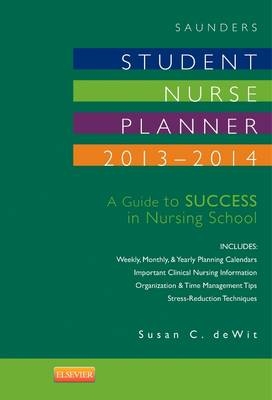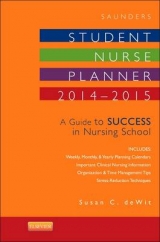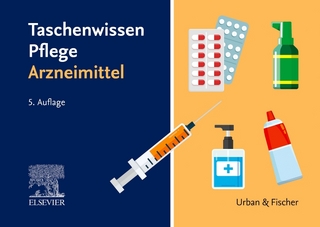
Saunders Student Nurse Planner, 2013-2014
A Guide to Success in Nursing School
Seiten
2013
|
9th Revised edition
Saunders (Verlag)
978-1-4557-7570-5 (ISBN)
Saunders (Verlag)
978-1-4557-7570-5 (ISBN)
- Titel erscheint in neuer Auflage
- Artikel merken
Zu diesem Artikel existiert eine Nachauflage
Much more than just a calendar, this title features a wealth of organizational tools, clinical information, and helpful nursing school guidance all within one compact and versatile resource.
Much more than just a calendar, Saunders Student Nurse Planner 2012-2013 features a wealth of organizational tools, clinical information, and helpful nursing school guidance all within one compact and versatile resource. Designed specifically for nursing students, the planner's strategies for time management and stress-reduction, planning sections, study advice, and abundance of helpful clinical tools can significantly reduce the common aches and pains of nursing school and help you perform to your fullest potential both inside the classroom and in clinical practice. You definitely don't want to leave orientation (or graduation) without it!
Time-saving, compact design provides a clean and efficient layout that is easy to take to bring along to class and clinical rotations.
Time management strategies help you perform to your fullest potential.
Advice on study skills and stress reduction techniques improve your focus and increase efficiency - giving you the edge you need to succeed.
Alternate-format questions (explanation and examples) and information on taking the NCLEX exam help prepare you for the licensure exam.
Getting the Most from the Clinical Experience chapter educates you on patient safety, communication with patients and colleagues, and documentation.
The Joint Commission's "Do Not Use" List of dangerous abbreviations, acronyms, and symbols appears inside the front cover.
Clinical Quick Reference chapter provides you with essential clinical tools and information in a concise, accessible format, and includes:
Commonly used abbreviations, symbols, and notations
Perioperative care and Joint Commission safety guidelines for surgery
Fall risk factors and assessment
Most commonly used IV fluids table
HIPAA requirements for confidentiality
Safety guidelines to prevent medication errors
Pain assessment tools
Signs of geriatric and pediatric abuse
Glasgow Coma Scale
Tips for troubleshooting IV pumps
Braden Scale for Predicting Pressure Sore Risk
Common lab test values
MyPlate dietary guidelines
NEW! Updated information on common therapeutic diets includes gluten- and lactose-free, high-fiber, and the DASH Eating Plan.
NEW! FOUR Score Neurological Assessment Scale guides you in assessing a patient's level of consciousness.
Much more than just a calendar, Saunders Student Nurse Planner 2012-2013 features a wealth of organizational tools, clinical information, and helpful nursing school guidance all within one compact and versatile resource. Designed specifically for nursing students, the planner's strategies for time management and stress-reduction, planning sections, study advice, and abundance of helpful clinical tools can significantly reduce the common aches and pains of nursing school and help you perform to your fullest potential both inside the classroom and in clinical practice. You definitely don't want to leave orientation (or graduation) without it!
Time-saving, compact design provides a clean and efficient layout that is easy to take to bring along to class and clinical rotations.
Time management strategies help you perform to your fullest potential.
Advice on study skills and stress reduction techniques improve your focus and increase efficiency - giving you the edge you need to succeed.
Alternate-format questions (explanation and examples) and information on taking the NCLEX exam help prepare you for the licensure exam.
Getting the Most from the Clinical Experience chapter educates you on patient safety, communication with patients and colleagues, and documentation.
The Joint Commission's "Do Not Use" List of dangerous abbreviations, acronyms, and symbols appears inside the front cover.
Clinical Quick Reference chapter provides you with essential clinical tools and information in a concise, accessible format, and includes:
Commonly used abbreviations, symbols, and notations
Perioperative care and Joint Commission safety guidelines for surgery
Fall risk factors and assessment
Most commonly used IV fluids table
HIPAA requirements for confidentiality
Safety guidelines to prevent medication errors
Pain assessment tools
Signs of geriatric and pediatric abuse
Glasgow Coma Scale
Tips for troubleshooting IV pumps
Braden Scale for Predicting Pressure Sore Risk
Common lab test values
MyPlate dietary guidelines
NEW! Updated information on common therapeutic diets includes gluten- and lactose-free, high-fiber, and the DASH Eating Plan.
NEW! FOUR Score Neurological Assessment Scale guides you in assessing a patient's level of consciousness.
1. Success in Nursing School
2. Getting the Most from the Clinical Experience
3. Dealing with Stress
4. Continuing Your Education
5. Clinical Quick Reference
6. Online Resources
Bibliography
Monthly Calendar
Weekly Planner
Index
| Zusatzinfo | Illustrated |
|---|---|
| Verlagsort | Philadelphia |
| Sprache | englisch |
| Maße | 152 x 229 mm |
| Themenwelt | Medizin / Pharmazie ► Pflege ► Ausbildung / Prüfung |
| ISBN-10 | 1-4557-7570-3 / 1455775703 |
| ISBN-13 | 978-1-4557-7570-5 / 9781455775705 |
| Zustand | Neuware |
| Haben Sie eine Frage zum Produkt? |
Mehr entdecken
aus dem Bereich
aus dem Bereich
Buch | Spiralbindung (2024)
Urban & Fischer in Elsevier (Verlag)
19,00 €



